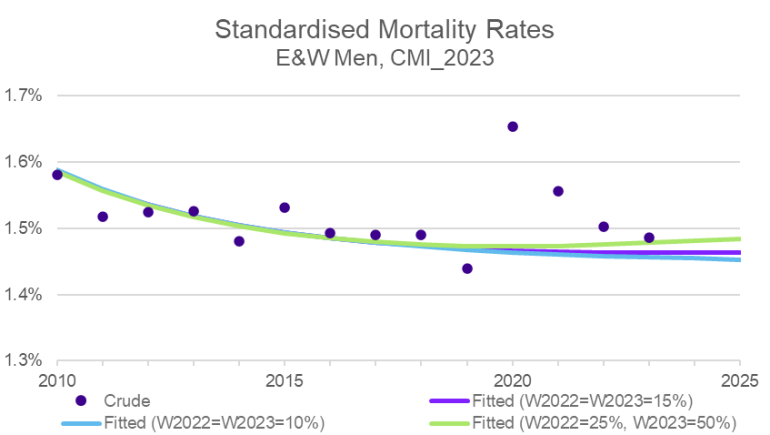Question:
What is the impact of recent updates to the CMI_2023 core parameters?
Answer:
The core CMI_2023 model provides a reasonable fit to pre pandemic England & Wales population mortality rates. However the fitted rates fall some way below 2023 experience, due to the low weights given to 2022 and 2023 data.
In my recent blog post I explored the fundamentals of what makes a ‘good’ mortality projection model, and measured the proposals from the CMI, as set out in their consultation paper, against those criteria. The key component of the consultation related to the weights that should be given to 2022 and 2023 data under core settings. At the time of release of last year’s model (CMI_2022), the CMI stated that they planned to place 25% weight on 2022 data and 50% weight on 2023 data. After reviewing 2023 data, they then proposed to instead apply 10% weights to both years. The CMI have now, following their consultation, decided instead to use 15% weights for both years in the final published model.
The chart shows the observed standardised mortality rates for men for England & Wales (purple dots) and how the CMI_2023 model smooths through these rates under this year’s initially proposed (blue line) and final (purple line) core settings for the model, as well as the expected weights that were set out last year (green line) – using an illustrative long-term rate of 1.5% p.a. throughout.

Source: CMI_2023 model (published with CMI Working Paper 189)
In a previous article, we explored in detail how introducing post-pandemic data can actually change pre-pandemic fitted improvements. This effect is again on show, especially in 2019, although in each case the model provides a reasonable fit for the pre 2020 experience. The different approaches to weighting post-pandemic data diverge more during recent years and into the future. Adopting 15% weights for 2022 and 2023, rather than the initial proposal of 10%, improves the fit to post pandemic experience slightly, while the previously outlined approach of 25% weight to 2022 and 50% weight to 2023 is a better fit (although it would produce negative improvements in the short term). For a 65 year old man in 2024, an annuity under the green line assumption will be around 0.7% lower than under the blue line assumption (based on a 3% net rate).
Key takeaways:
- The CMI model continues to provide a good fit to pre pandemic experience.
- However, it is proving much more challenging to fit more recent experience.
- The model is sensitive to the assumptions made about the weights given to recent years. None of the three approaches to weighting 2022 and 2023 data is particularly unreasonable; however they result in a range of 0.7% difference in annuity values for a 65 year-old male in 2024.
- This makes the model inherently more subjective than versions fitted to pre pandemic data, relying much more on expert judgement to calibrate the model than an objective data-driven approach.
- The CMI recognise the inherent challenges, and plan to undertake a wider review of the model’s methodology over the course of the year, in advance of the CMI_2024 version.
Why does this matter?
The CMI model is the de-facto industry standard in the UK for setting mortality improvements. Many end users will adopt the core settings, without necessarily fully engaging with the implicit assumptions underlying them. This is particularly pertinent as the level of subjectivity in the model increases. There is a risk therefore that some users may not fully appreciate some of the subtleties, for example the risk of ‘double counting’ the pandemic impact if the core model is combined with base mortality rates that also reflect pandemic experience.
For more details on the criteria for a good mortality model, and how the CMI_2023 model compares against those criteria, see my recent blog post.




